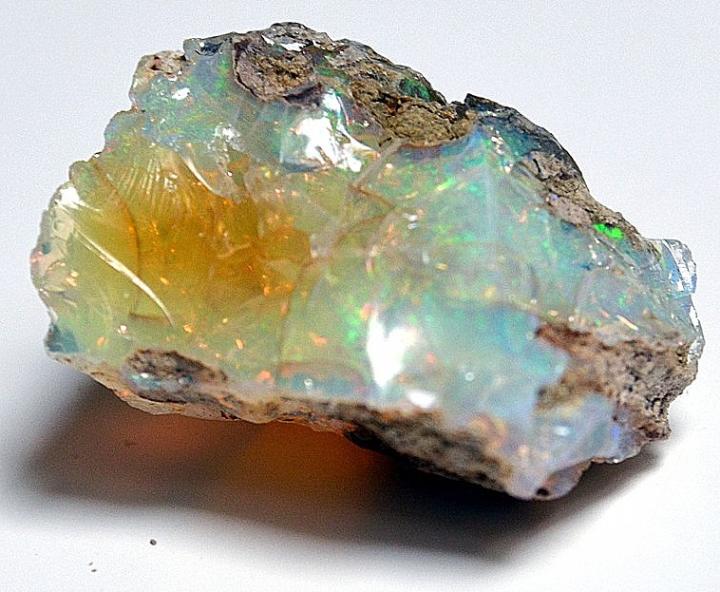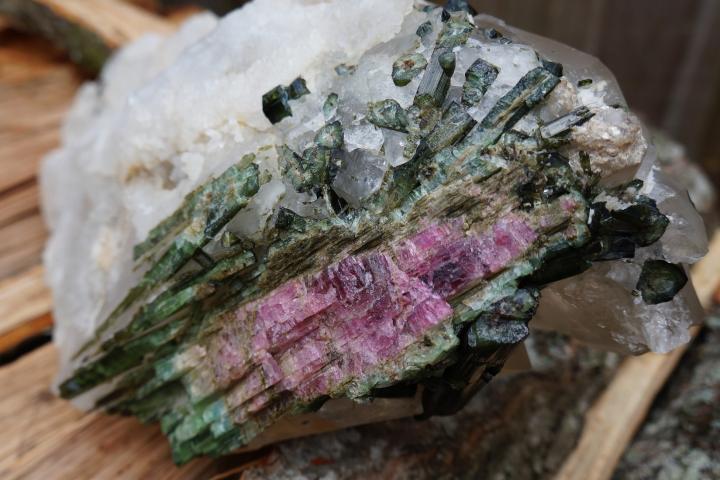Source: https://www.almanac.com/october-birthstone

By Tim GoodwinSeptember 21, 2022
The array of colors contained within a single precious opal was once thought to possess the powers and benefits of all colored stones. The opal, a symbol of love and hope, has long been associated with luck—both good and bad. Learn more about the history, meaning, and symbolism of the opal and the tourmaline
Opal
Opal’s Color
The most well-known opals are traditionally classified as black or white, but other base hues include red, purple, and orange. The presence of certain chemicals is what creates the gem’s background color.
But the opal is more well-known for its kaleidoscope-like appearance with flashes of blue, green, orange, and red that give the opal its play-of-color identity.
The play-of-color in opals occurs due to microscopic spheres stacked together in a grid-like pattern. As light passes between the spheres, the light waves diffract or bend. When this happens, the lightwaves break up into the various colors of the rainbow.
There are two classes of opals—precious and common. Precious opals display the dazzling play of color, while common opals do not. Opals can range from opaque to translucent to transparent.

Opal Meanings, Symbolism, and Folklore
- Some believe that the opal name comes from India, where it was called upala in Sanskrit, meaning “precious stone.” Others theorize it began in Greek, where opallios, meaning “to see a change in color,” was used to describe its colorful appearance. In ancient Rome, it was referred to as opalus or “precious jewel.” Pliny the Elder referenced the stone’s play of colors that covered every shade of the most sought-after gems.
- For hundreds of years, due to its colorful array, opals were thought to contain the powers and positive benefits of all colored stones. Romans believed it was the most precious and powerful gem and a symbol of love, referred to as the Cupid Stone. That has led to some believing it holds the power to promote romance and passion. It has long been a symbol of hope, purity, and truth.
- Nomadic Arab tribes believed the opal fell to Earth during thunderstorms and held lightning inside.
- Ancient Greeks felt that opals would present the gift of prophecy—the ability to see into the future.
- At one time, the opal was said to be able to create invisibility powers for those who wore it.
- Some believe in the opal’s power to improve or promote the health of the eyes.
Where Does Opal Come From?
Opals are created when water containing silica deposits finds its way underground into the openings between layers of rock. When the water evaporates, a solid deposit of silica—a compound of silicon and oxygen—is left behind. Opals can contain up to 20 percent water trapped within its silica structure. The silica deposits are what formed into the opal.
When opals were first mined commercially in Australia in the mid-19th century, the country quickly became the primary—and most productive—source for the gem. Lightning Ridge, a small town in New South Wales, is well-known for producing some of the finest black opals. Locations in Ethiopia (white, yellow, orange), Mexico (yellow, orange, reddish-orange), and Brazil also serve as important sources, while other deposits have been found in Central Europe, Honduras, Indonesia, and the United States.
Opal in History
- Numerous writers, including Pliny, have compared the dramatic play of color to fireworks, galaxies, and volcanoes. But one writer gave the opal a bad reputation as being unlucky: In “Anne of Geierstein,” by Sir Walter Scott, Anne wore a golden clasp containing an opal that changed colors when she was animated or agitated. Others did not agree with the idea that it was bad luck, believing that opals were in fact the luckiest—and most magical—of all gems.
- The world’s most valuable opal is the Olympic Australis. It was discovered during the time of the 1956 Summer Olympics (held in Melbourne, Australia) and once held the Guinness Record as the biggest opal.
- In addition to being a birthstone for October, opals are also given for a 14th wedding anniversary.
Opal in Jewelry
With a 5.5 to 6.5 Mohs Hardness rating, opals are susceptible to scratching and are more suitable for wearing on special occasions rather than every day. At the same time, the versatility and beauty of opal jewelry is worth the extra care needed to clean it and keep it safe. To prevent damage, store opal jewelry away from other gems.
To clean opals, use warm, soapy water. Other methods can damage your opal or the filler material used, especially in opal doublets and triplets—man-made stones where slices of opal are glued together.
Tourmaline
Tourmaline’s Color
Very few gems can match tourmaline’s range of colors, which includes every shade of the rainbow—reds and pinks, emerald to neon green, deep blues, purples, and yellows. Some stones even have multiple colors.
Tourmalines are a large group of boron silicate minerals. The gems share a common crystal structure and have similar physical properties, but their chemical compositions vary greatly. The presence of different elements is what allows the gems to exhibit such a wide range of colors.
Some gems also have an effect called cat’s eye, which often includes green, blue, or pink.

Tourmaline Meanings, Symbolism, and Folklore
- The name originated from the Sinhalese (Sri Lanka) word toramalli, meaning “stone with mixed colors.”
- The tourmaline was once thought to inspire artistic expression since it had a color for every mood.
- Ancient Egyptians believed the range of colors was caused by the gem’s long journey from the center of the Earth, at which time it passed over a rainbow.
- It has long been associated with friendship and those who wore it would have long-lasting relationships.
- Black tourmaline is thought to bring about confidence; pink is associated with compassion; green is believed to promote courage and strength.
Where Does Tourmaline Come From?
The chemical makeup of a tourmaline gem influences its physical appearance and coloring. In fact, it is not one mineral, but a complex group of minerals with varying chemical compositions. It most commonly occurs in voids and cracks in igneous and metamorphic rocks, forming during hydrothermal activity.
The most prominent source of the gem is Brazil, but it is also found in Afghanistan, Pakistan, Madagascar, and a number of countries in Africa. In the United States, southern California and Maine have produced the gem for more than a century.
Tourmaline in History
- With its wide array of colors, tourmaline was often mistaken for other gems, including the Caesar’s Ruby pendant in the Russian crown jewels. It was confused with other gems for centuries until tourmaline was recognized as its own mineral species.
- Tourmaline possesses the ability to become electrically charged through heat and pressure, where it can become a magnet by oscillating and attracting dust particles.
- In the early 1900s, China represented one of the largest tourmaline markets. When the Chinese government collapsed in 1912, the tourmaline trade took a down turn.
- Tourmaline is given to celebrate an 8th wedding anniversary.
Tourmaline in Jewelry
With a Mohs Hardness rating of 7.0 to 7.5, tourmaline is an option for everyday wear in jewelry such as rings, earrings, and bracelets. Heat can damage the stones, so use lukewarm, soapy water and a soft brush to clean.

